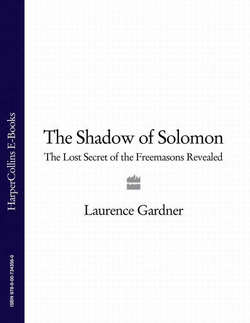Читать книгу The Shadow of Solomon: The Lost Secret of the Freemasons Revealed - Laurence Gardner - Страница 30
The Dunkerley Episode
ОглавлениеPrince Frederick predeceased his father in 1751 and, when George II died in 1760, he was succeeded by Frederick’s eldest son as King George III. Soon afterwards, following an induction meeting at the Horn Tavern in London, three of the new King’s brothers—the Dukes of Gloucester, York and Cumberland—were each given the spuri ous title of Past Grand Master by premier Grand Lodge.21 This ensured that the Royal Family was wholly attached to their branch of the Craft, while also giving the impression to outsiders that Grand Lodge had a more solid foundation than in reality. From that point, the scene was set for a masonic institution headed by Hanoverian royalty, as it remains today.
The American War of Independence (1775-83) was a major world event in masonic terms since George Washington, John Hancock, Benjamin Franklin and other Founding Fathers of the emergent new Republic were Freemasons. But how could these eminent men be attached to a fraternity that was so heavily influenced by the very royal house whose colonial authority they challenged?
This fascinating aspect of transatlantic history is more than worthy of its own section in this book, and it shall be examined in detail in chapter 17. Meanwhile, the point to hold in mind is that the Tory Ancients and the Whig Moderns were competitive, antagonistic, and supported wholly conflicting political viewpoints. There were two distinct and opposing forms of Freemasonry in the latter 1700s, and the relationship between America and the Tory faction was far stronger than any academic history book is ever likely to reveal.
In 1782, Prince Henry, Duke of Cumberland, was installed as overall Grand Master in London and, with this formal royal patronage, the masonic cause of the Moderns was considerably strengthened. Another prominent character of the moment, known as Thomas Dunkerley, was an illegitimate son of George II. Born in 1724, he served (from the age of 10) in the Royal Navy, and his royal birthright was not announced until he was over 40. Having been initiated into Freemasonry in 1754, Dunkerley formed lodges in many of the ships in which he served, and when his parentage was recognized he was granted a personal income and rooms at Hampton Court Palace. Subsequently, he became Provincial Grand Master in numerous regions.22
The Duke of Cumberland died in 1790, whereupon his nephew, the Prince of Wales (later King George IV), took up the reins as Grand Master—at least nominally. In practice, he appointed a deputy to carry out the functions of the post.
In 1791, Dunkerley decided to introduce high degrees of a presumed Knight Templar style into English Freemasonry. He formed the Supreme Grand and Royal Conclave, inviting George III’s young son, Prince Edward (the later Duke of Kent), to be overall Patron of an Order that would assume control of the said high degrees. But Dunkerley died in 1795, and no one really knew what the Supreme Grand and Royal Conclave was. It seems to have been little more than Dunkerley himself, possibly with the aid of a friend’s sister, whom he referred to in correspondence as the Lady Patroness. There were, however, a number of regionally affiliated ‘encampments’ (lodges) whose members appointed Thomas Parkins, Lord Rancliffe, to succeed Dunkerley. But in all the 11 years of his appointment, Rancliffe only attended one meeting,23 which was one more than the Duke of Kent attended!
